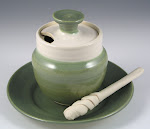The four carved vases were bone dry and it was time to bisque fire them, then glaze them. But I don't think these pots lend themselves to regular glazing. Colored glazes might war with the complicated, busy carving, or mute it. I know from experience that clear glaze alone would be too dull on the buff colored stoneware clay body.
I had a couple of jars of underglazes, though, which are formulated to go on raw pots. There were only light blue and black underglazes, so that is what I used. The photos show the four vases with these underglazes, which I put on fairly dry with a small foam roller and a flat sponge brush. The surfaces of the vases have almost an ink-printed effect. They will be bisque-fired in the old reliable electric kiln later in the week. Afterward, I will clear-glaze over the fired underglazes and fire the pots again.
This is Stage II of the vase story. Tune back to see how the finished, clear-glazed vases come out. I can't wait to see, myself.
Subscribe to:
Post Comments (Atom)





They look so incredibly intricate! Beautiful!
ReplyDeleteI wish I had a greater appreciation for the technical jargon though...
Not so technical, really! Lucky for you I kept the jargon short! At this point it's 2nd nature to me, and I didn't even realize it might seem technical till you pointed it out. Think of this- clay is weathered rock combined in malleable form. After being formed and heated, it becomes rocklike again- but with human intervention as to shape, color and texture. That is pretty amazingly cool.
ReplyDeleteHi Tanta. I really like the pattern on the top vase, especially towards the bottom where the staggered strokes create meandering horizontals. At the same time I like the way the bottom vase's pattern engages the neck.
ReplyDeleteThanks, Architectman. I value your response.
ReplyDeleteSo far I have liked every piece that you have shown here.
ReplyDelete